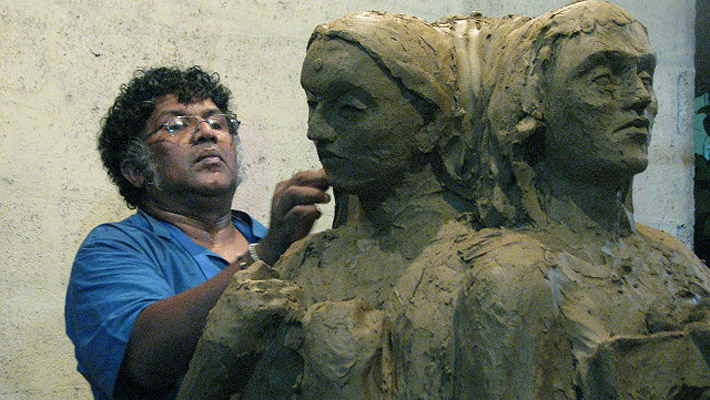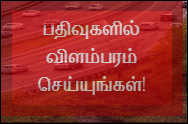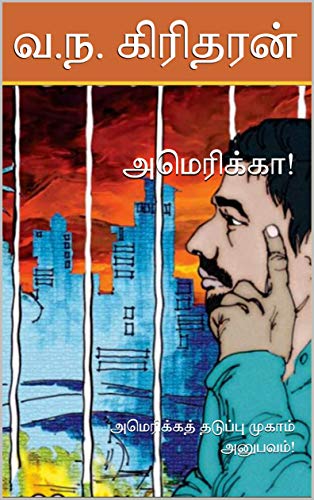 In 1997, Chandragupta Thenuwara coined the term 'Barrelism' as a way of conceptualizing his opposition to militarization. As the barrels kept invading city squares, urban streets and many other public spaces, he converted the barrels painted in camouflage into works of art. Instead of artistic reproduction of landscapes, he created 'barrelscapes' using the empty exhibition spaces of the art galleries. "If someone asked me to portray the present state of Sri Lankan society, I have nothing to draw but barrels. Barrels have occupied the space around us. Barrels have blocked my view. How can I paint the sky as it hardly can be seen?" he asked during an interview in 1999. Since then more than a decade has elapsed and the war has paused. "We now live in a post-barrelist stage, surrounded by new symbols of militarization" he said to JDS, while his latest exhibition of sculpture and drawings - 'The Monument and Other Works' - is being held at Lionel Wendt Art Gallery in Colombo. Returning to the island in 1993 after completing his postgraduate studies at the Moscow State Art Institute, Thenuwara became head of the Vibhavi Academy of Fine Arts - better known as VAFA - apart from lecturing at the Faculty of Aesthetic Studies at the Colombo University. He was an artist in residence at CAIR, Centre for Art International Research at Liverpool John Moores University and served as a Board Member of the Architectural Association Foundation in London in 1996-97.
In 1997, Chandragupta Thenuwara coined the term 'Barrelism' as a way of conceptualizing his opposition to militarization. As the barrels kept invading city squares, urban streets and many other public spaces, he converted the barrels painted in camouflage into works of art. Instead of artistic reproduction of landscapes, he created 'barrelscapes' using the empty exhibition spaces of the art galleries. "If someone asked me to portray the present state of Sri Lankan society, I have nothing to draw but barrels. Barrels have occupied the space around us. Barrels have blocked my view. How can I paint the sky as it hardly can be seen?" he asked during an interview in 1999. Since then more than a decade has elapsed and the war has paused. "We now live in a post-barrelist stage, surrounded by new symbols of militarization" he said to JDS, while his latest exhibition of sculpture and drawings - 'The Monument and Other Works' - is being held at Lionel Wendt Art Gallery in Colombo. Returning to the island in 1993 after completing his postgraduate studies at the Moscow State Art Institute, Thenuwara became head of the Vibhavi Academy of Fine Arts - better known as VAFA - apart from lecturing at the Faculty of Aesthetic Studies at the Colombo University. He was an artist in residence at CAIR, Centre for Art International Research at Liverpool John Moores University and served as a Board Member of the Architectural Association Foundation in London in 1996-97.
Excerpts of the interview follow:
JDS: You have made a comeback with your latest exhibition of sculpture and drawings which is titled "The monument and other works". Why 'The monument?'
Chandragupta Thenuwara: The 'Monument' is a sculpture of four women, facing four different directions while remaining bound to each other. They stand in the exhibition space staring at empty walls of the gallery. These four figures represent the four ethnic communities in the island. The one who is facing south is a Sinhalese while the Tamil woman is looking northwards. The Muslim towards the east and the Burgher, the west. There is more to this, which I will explain.
At least officially, we all know that it has being almost three years since the war ended. But the end of the military conflict did not deliver a solution to the underlying deep rooted political issues. Instead of a solution, now we live under more threats and more fear. The rulers of the country have clearly showed that they are more interested in convincing the masses about the importance of living with fear. Apart from open threats, numerous methods are being used to spread this message of fear. People are being abducted and then they go missing without a trace. Especially in the Tamil areas, the things have become unimaginably bad. They don't know who is living - who is missing, who is imprisoned or who has been killed. We all have a right to know such matters. The dead deserve dignity while the living needs truth and justice. But here, we get nothing.
The missing are mostly men. So the overflowing grief is always manifested through women who take to the streets. During the 1987 - 89 period, when hundreds of thousands of men and women were killed in the south, we put the blame on the 'patriots' or the 'Sinhala subversives'. When the war in north-east was going on, many preferred to put the blame on the 'terrorists'. Now there are no armed uprisings in the north or in the south. Tell me, to whom shall we put the blame on?
Therefore we have to look back on, retrospectively, and in a self-critical manner. What has happened to us? What has happened to others? All these questions need to be answered.
JDS: In Sinhala language, the 'Monument' implies something static, fixed and mostly immovable. For example, many understand it as something similar to the 'Monument for the Disappeared' situated in Raddolugama, which was also created by you. But when publicising the exhibition in Sinhala, you seems to have preferred using the Sinhala word ‘Samaadiya’ which is more close to the word 'composure' instead of using a literal translation of the word 'Monument'. Interestingly, in a Buddhist context, the term 'composure' usually has a religious connotation. Tell me, was using a word that contains a religious undertone decided consciously?
CT: Well, it is true to some extent. Today, the Sinhala Buddhist component turns out to have been over-determined in the so called 'post - war discourse'. As always, it is still the dominant ideological component. So naturally, the term 'composure' or 'Samaadiya' makes more sense to many people than the word 'monument'. Yes, therefore it is a conscious decision and what you see in the exhibition, is a four women's composure reflecting the hopes of the victimized women. Those who prefer to uphold Buddhist tolerance, are compelled and forced by the this 'monument' to reflect and rethink. So, instead of depending on the literal meaning of the English word 'Monument', I simply thought it's better to dance around the word a bit, hoping to generate multiple and diverse meanings.
JDS: Do you think the society around you has the potential or the capability to appreciate your art? According to your observations, what sort of people visit your exhibition and which social layers do they represent?
CT: People visiting the exhibition represent a wide range of social strata and diverse ethnic backgrounds. Since the opening of the exhibition, we observed the members of the Colombo's middle class and the upper middle class as well as people who belong to lower social layers visiting the gallery. Besides ordinary art lovers, there had been a sizable number of political and civil society activists among the enthusiastic viewers. Most of them have been appreciating my artistic work for a long period of time and have showed a keen interest in interacting with my work. One such person told me that the gallery provides them a space to express themselves freely as they communicate with my art and once they leave the exhibition hall, they are forced to retreat to the silence and to hold back their views and opinions. This demonstrates the level of fear surrounding us.
Some of them were interested to know why I want to get involved in politics instead of continuing my work just as an artist. But my art and my politics are inseparable. My political beliefs are expressed and reflected through my work of art and therefore, such a division seems pointless to me.
The other interesting thing is, despite the fact that there had been many viewers who are active in politics, I didn't see any politician from the ruling party.
JDS: Does it surprise you at all? How can you expect them to be part of the viewers when your work itself represent the opposition to their politics?
CT: Of course I am not surprised. I just wanted to point it as a matter of fact. Though it may sound somewhat funny, I believe my artistic freedom mostly depends on their absence! Once they are keen to know what my art is all about, that would make things difficult for me. Moreover, their absence provide more freedom for the rest of the art viewers to behave freely, interact freely and express themselves freely - within the gallery space.
JDS: You said that your artistic work and your political convictions are inseparable. Why?
CT: My true strength is my involvement in the political space as well as my ability to interact with others politically. My artistic observations on society is highly motivated by my political interaction with the rest of the community. It sharpens my insight and inspires me to a great deal. Therefore, my art and my social activism are inseparable. But at the same time, I am able to leave my emotions and impulses on the street and transform the social experience into art without being carried away by my own emotions. When I am doing art, I become a distant observer of my impulses, flowing from my own emotions. But I believe it is important to maintain the link between these two, instead of recreating my personal desires and dreams into art. For that, my presence and involvement in the political space is quite important for me.
JDS: How do you explain and understand the contemporary societies, both in north and south?
CT: I think one of the most salient characteristic of our society, which is still quite visible, is the fact that we have been guided not by wisdom or rational thinking, but by 'fear'. For almost 30 years, the war has been used as the sole reason to generate and maintain this 'fear' factor. But since the war ended, the ruling block is desperately looking for new wrapping papers that can be used to wrap the 'fear' and present to the population. The desperation of the rulers makes it more threatening and more destructive. So, all sort of nonsense, ranging from national defence to state sovereignty can be seen repeatedly tested to generate more 'fear'.
I would like to name this era as a 'era of nomadic hunters'. When carefully examined, you will find that our contemporary society embodies certain central characteristics of nomadic hunting societies dominated by the hunter gatherers. I know this may sound a bit absurd and therefore
it needs further elaboration. What I mean here is , that generally the hunter does not make himself visible all the time. But the rest who are likely to become the prey, know the hunters are roaming around and can strike at any moment. So it's a primordial social formation where hunters and their prey coexisted - just like ours. The citizens have become the prey for the hunters who roam and make themselves visible in time to time. We know that at a certain point we may end up by becoming their prey. But we go on living with a sense of fear until that happens. Even though there is always a possibility for survival, the fear remains that we may not survive. So, our total existence is ruled by a sense of fear - just like in the old days.
You can be hunted down at any time for any unknown reason if the rulers see you as a threat. You can be accused of betraying the nation, or inciting public unrest or endangering the state sovereignty and so on. So the hunters who rule and roam around have revived our natural instinct to survive. We keep calm and lie low to make sure that we don't draw the attention of the hunting mobs and we call it a life and we call it a 'democracy.'
JDS: You reflected our militarized life and society through your own artistic concept of 'Barrelism' - using actual barrels as a work of art, painted in camouflage and differently designed. With the end of war, has the relevance of barrelism ended too?
CT: I don't think so. My exhibition marks a newest moment of the post-barrelist period. After seeing the exhibition, Vikramabahu Karunaratna, who is a veteran leftist and an intellectual, asked me whether my intention was to propose a 'Barbed wire stage' which follows the previous 'Barrellist stage'. What I really think is that, even though the barrels have moved out of our sight as the primary symbol of militarization, the process itself has not ended. It still occupies a large space of our collective life. Take the example of Jaffna. On one hand, the soldiers who were glorified in the south as the heroes of the Sinhalese, are still being kept confined to the same military garrisons just like during the war time. On the other hand, the conditions of the Tamil people have become more appalling and miserable. Jaffna has become an occupied space which is maintained for the consumption of the outside tourists. It has now being turned into a re-invented and a re-interpreted space where the destroyed Hindu temples are being replaced by Buddhist temples while the entire region is gradually converted into a colonized landscape. The native population is forced to live like ghosts. If not for the deepening economic crisis, the colonization would have thrived even more. But no one in the south understand the gravity of the conditions of the people living there. It's a kind of 'barbed wire condition.' You cannot reach the others as you being kept away from understanding the plight of the others.
JDS: Now it is a widely accepted fact that at least 40,000 Tamils may have been massacred during the last stages of the war. As an artist, how do you respond to such a horrendous genocidal crime?
CT: It is indeed horrendous and unimaginably brutal. But no one even dare to talk about it, let alone investigating these crimes. To think about the plight of the fellow human beings who physically shared the same territorial space with us is totally prohibited in a country which calls itself a 'Socialist Democratic Republic'. No one knows about the true gravity of the crimes. If even the basic right to know about such crimes is denied, there is no way we could move forward. During the Second World War, the Russians massacred at least 4000 Poles in the 'Katyn forest', which neighboured a small Polish village. The crime which later became known as 'Katyn Massacre' remained hidden for over 40 years, but eventually resurfaced. It is no longer considered as a 'secret' and everybody knows about it. So, the crimes cannot be guarded as 'secrets' for ever. It is simply a matter of time.
As I said, the dead deserve dignity and respect. They need to be buried by letting the survivors know how they died. If we deny their right to know, the dead will keep haunting us for ever. The unburied dead will resurface time to time. Just as we believed in the past that this is relevant to the two generations of Sinhalese massacred in the '70s and in the '80s, it is equally relevant to the generations of Tamils who were massacred. In my drawings you may notice that there are unburied dead bodies lying around. The unburied dead is not just a matter of justice, it is also a civilizational issue.
JDS: But you have been an outspoken supporter of the former Army Commander General Sarath Fonseka before and after his failed presidential bid against Mahinda Rajapaksa. As someone who conceptualized the threat of militarization through'Barrelism' and emphasized the inseparability of 'artistic observation' from the'political interaction', do you see a conflict between your own artistic and political viewpoints?
CT: I agree that there there are some complex issues involved here. But still, my stand against the war always remained unwavering. Regardless of the question who led the war, I maintained my position against the war, a stance I still believe in. But after winning the war, Fonseka's interaction with the society was different. We need to recognize that there are two different characters. On one hand he is a military officer, who pursued a military option in order to safeguard the status-quo, which is pro-state. We should deal with that officer on a different level and General Fonseka himself has stated that he is open to discuss such matters. But on the other hand, he is a politician with a potential and a capability to lead the masses. The people who spent their time in air-conditioned rooms and now trying to capitalize on war victory, can claim anything to keep their grip on power.
We never promoted Sarath Fonseka as a military officer during his time in the army. We only defended him when he became a political prisoner and a direct victim of the current authoritarian tendency. We would not compromise our right to question him about the role he played as the Army Commander. But at the moment, what matters most is not whether he had been in the army or whether he had been a 'Tamil Terrorist.' What is of greater importance is whether or not we want to have a free country. That was the position I held when I decided to join the movement which campaigned for his release. If he says that he is willing to fight for democracy, I too have a responsibility to interact and influence him as someone who uphold democratic values.
Courtesy: http://www.jdslanka.org/index.php/2012-01-30-09-31-03/media-a-culture/164-we-live-in-the-age-of-nomadic-hunters-chandragupta-thenuwara
[08 AUGUST 2012 ]




